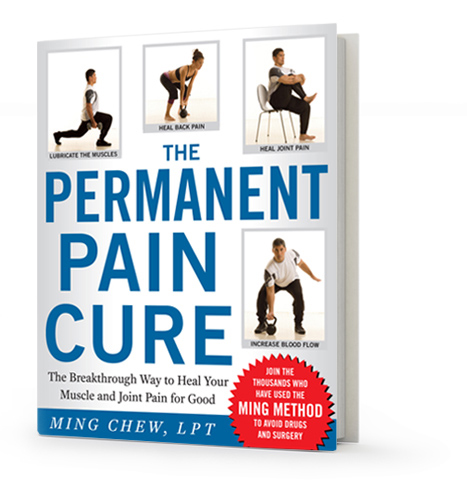The Permanent Pain Cure
Permanent Pain Relief with the Ming Method
You have arthritis. A bad back or knee. Or you were injured. You’ve tried everything—drugs, physical therapy—but the pain won’t go away. You’ve seen several specialists, and they’re talking surgery. You hate the idea—but do you have a choice?
Ming Chew has a message for you:
Surgery should be your absolute last resort. Before even thinking about surgery, try self-therapy with the Ming Method.
In The Permanent Pain Cure, master pain therapist Ming Chew introduces you to the Ming Method: a safe yet powerful self-help system that heals pain problems most medical professionals believe can only be treated with drugs and surgery.
Buy from Amazon Buy from Barnes & Noble
Read an Excerpt from the Introduction
Click here to download the entire Introduction as a PDF.
CHAPTER ONE
Introduction
The Body United by the Fascia
In 2003, National Basketball Association (NBA) star Jason Kidd injured his left knee. For five months, the New Jersey Nets sent him to various specialists, who all failed to help. Kidd was facing knee surgery at the end of the season. Then his agent heard about me and the Ming Method. Willing to try even a weird alternative therapy if it could save him from the knife, Kidd came to my office, just before play-off time. After one treatment session, his knee was 70 percent improved. After a second session, his knee was fixed, and he was back on the court.
Before this treatment, Kidd had been afraid his season was over. But, he said later, “With the procedures Ming used I was able to play and help my team in our play-off run that season. I had never experienced the things he did with me, and I know they were cutting-edge techniques. He really helped me.”
Kidd then sent me New York Yankees first baseman Jason Giambi, who told the New York Times, “My legs felt really dead, and when I came out of there, my legs felt good.” And when I healed Men’s Health writer Lou Schuler’s shoulder problem—which dated back to a high school injury twenty-six years before—he claimed he’d been “both witness to and beneficiary of a miracle.”
So am I a miracle worker? Not really. My work is based solidly in science. But I routinely heal injuries, aches, and pains that most medical professionals believe can be fixed only by medication and surgery. I do this by treating a little-known tissue that’s almost completely ignored in medical schools and physical therapy training: a type of connective tissue called the fascia, which envelops every muscle, nerve, and organ in the body.
In fact, the biggest difference between what I do and traditional orthopedic medicine and physical therapy is that they don’t address the fascia. As a result, countless injuries that could be completely cured through releasing contraction and tightness in the fascia are treated incompletely with pain medication, muscle relaxants, and surgery.
Not just physicians and physical therapists, but many other professionals who work with the body know little about the fascia. Most traditional chiropractors, for example, don’t address it at all, which in my opinion is a serious mistake. Adjusting a section of the spine without first loosening up the fascia is actually dangerous, because whenever there’s an injury, the fascia adheres to itself and to other soft tissues, and administering a sudden twist can cause all these tissues to tear. More modern chiropractors do prepare the fascia before making adjustments, and in that case the treatment is likely to be safer and more effective.
Most massage therapists understand the importance of the fascia. But in order to make the kind of changes in the body structure that can really heal an injury, the fascia must be actively stretched, and in massage therapy the patient doesn’t move. Though massage can help stretch the fascia, on its own massage has only a limited effect. I see it rather as a perfect adjunct to the program this book offers.
Alternative-therapy techniques, such as acupuncture and shiatsu, open up the energy flow in the body but don’t address contraction and tightness of the fascia. I believe that these treatments would work better if the fascia were released beforehand.
Since most personal trainers are unfamiliar with the fascia and thus unaware of the major role it plays in movement, their clients miss out on the tremendous benefits of fully functioning fascia for both performance and injury prevention. And while yoga and Pilates training stretch the fascia, most instructors don’t make this a focus of the practice. In any case, the work in yoga and Pilates generally is not detailed enough to address specific parts of the fascia, so there are many body problems that these disciplines can’t resolve.
All these treatment modalities have value. But none create permanent change, since the fascia can be effectively healed only by stretching, proper nutrition, and being supplied with adequate water (hydration). Very few people have the skill of releasing the fascia specifically. It’s an art form, so little known that it’s almost uncharted territory.
But I was trained by the experts who created this art form. For twenty years, I’ve worked on all kinds of people and seen every soft-tissue injury known to humankind. I’ve successfully treated injuries whose causes ranged from weight lifting, jujitsu, and basketball to sitting long hours at a desk hunched over a computer—all through manipulating the fascia.
Click here to read more.

